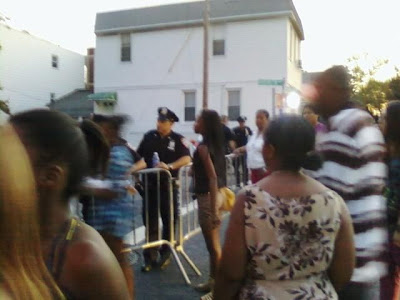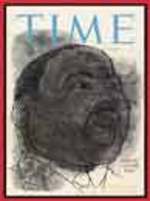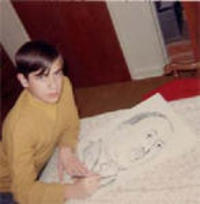Aside from teaching seven classes at four different local colleges, writer Richard Grayson is the author of “I Brake for Delmore Schwartz,” “With Hitler in New York,” and “To Think He Kissed Him on Lorimar Street.” OTBKB is honored to present his ocassional columns. What a gift.
by Richard Grayson
Several bus routes go east-west through nearly all of Brooklyn; closest to the center of the borough is the B35, Church Avenue/39 Street, which stretches from Brownsville to Sunset Park.
Many Brooklyn bus routes are based on the old trolley routes. The Church Avenue trolley is the only one I can recall riding; it was one of the last routes to go, lasting until I was five. On trips from her house to ours, Bubbe Ita, my great-grandmother, would let me stand on the wicker seat and pull the cord to request the stop.
The B35 begins at Mother Gaston Avenue, but I walk a few blocks up to where I began – at Brookdale Hospital, Beth-El Hospital in 1951, where I was delivered by the same Park Slope GP who’d delivered my mother twenty years before. I pass streets reflecting the earlier neighborhood ethnicity, Herzl Street and Strauss Street – but at Rockaway Parkway, Church Avenue’s alternative name is Bob Marley Boulevard.
I once told someone in South Florida who asked me where I was from in Brooklyn, “Around Church and Utica,” and the guy, a Jamaican, said, “That’s not Brooklyn; that’s the West Indies.” The familiar colors of the Jamaican flag are on local storefronts and posters.
West Indians started to move into East Flatbush in the late 1950s, about the time we left our apartment on East 54 Street just south of Church for our new house in Old Mill Basin. All our relatives left the neighborhood as “blockbusters” came in and scared the white people into moving. Both sets of my grandparents left in 1967 for Rockaway.
The last time I went to our old block was in 1980, when black friends brought me along to a party given by Carol, whose Jamaican father, it turned out, owned the apartment building on the corner. When I told Carol that I’d lived on this very block until 1958, she said, “Oh, I envy you. It must have been beautiful here before the Haitians came and ruined it.”
Around here, as in other places, Brooklyn’s varied street numbering patterns collide: on one side of Ralph Avenue, it’s the East 90s; on the other side the East 50s.
We pass the East Flatbush branch library, hair braiding places, Jerk City and the Brooklyn Jerk Center, and an inspirational mural of a (Caribbean?) beach with manna from heaving falling upon it. I spot, behind a car wash by Kings Highway, the third-story window of the bedroom where I misplaced my virginity in the spring of 1971.
Storefront houses of worship, like the Reviving Revelation Revivalist Pentacostal Church, its sign decorated with a crown, a cross, and a star of David, line Church Avenue. On lampposts are many signs of the times, all with some version of AVOID FORECLOSURE! By now the bus is jammed.
Most of the stores from my childhood are gone, of course, but SilverRod Pharmacy at the corner of Utica and Church, the crossroads of our neighborhood, still stands. As we stop, the driver calls over the PA system:
“Does anyone know where Kingsbrook Hospital is?”
I hesitate, then yell out, “Get out here and take the Utica bus four or five blocks north and then go left a few blocks.”
“Are you sure?”
“Pretty sure,” I yell. I decide not to add how I know: “My grandmother had rectal surgery there.”
I’m the only non-black person on the bus.
In the East 40s we pass restaurants like Linda’s Guyanese, West Indian and American Cuisine. Every three or four blocks, the numbered streets are broken up by streets named after cities: Utica, Schenectady, Troy, Albany, New York, Brooklyn (Saratoga, Kingston and Buffalo don’t go down this far).
We see more churches – Eglise Baptiste and Iglesia Pentecostal – as well as day care centers, a fast-food vegetarian restaurant and a storefront P.S. 245. At Nostrand Avenue lots of people leave for the subway. The corner Granada Theatre is long gone, in its place the Guyana Gold jewelry store. Banners decorated with a palm tree on a beach proclaim “East Flatbush, the Caribbean Heart and Soul of Brooklyn.”
Soon East Flatbush becomes Flatbush, and we’re at Flatbush Avenue, across from the old Dutch Reformed Church that I assume gave the avenue its name. This area was the Broadway of Brooklyn, with seven or eight theaters that no longer exist. The Kenmore, right by the bus stop, is a Modell’s Sporting Goods store.
On the other side of Ocean Ave, near the B/Q train station, is West Indian Farm, a great place to buy Caribbean produce. At the subway stop, an Indian woman in a sari gets on, along with Hispanic people and old Jewish man who sits beside me, replacing the woman who was reading the Bible in Creole.
On the south side of Church, brick stanchions with the PPS crest signal Prospect Park South, and both the fronts and sides of Victorian homes line the street. For a few blocks, English street names displace the East Teens: Rugby, Westminister, Marlborough, Stratford, Buckingham, Argyle.
Past Coney Island Avenue and where Ocean Parkway becomes the Prospect Expressway, the signs proclaim Kensington’s ethnic mélange: Transfer D’Argent Haiti, a taqueria, a giant yeshiva, Mazowsze Polish Deli, Plaza 5 de Mayo, Productos Mexicanos, Pinosha Albanian Village, Kadima Cell Phones, food from Russia, Israel, Ukraine, Poland, Turkey. Just past Yummy Taco by McDonald Avenue’s F train el, a woman in a burqa pushes a shopping cart past Bangladesh Hair Design.
The East numbered streets are gone now as Kensington bleeds into Boro Park, and Church Avenue ends, diagonally interrupting the plain-numbered streets and avenues that dominate western Brooklyn.
The bus goes up 36 Street past auto body shops, a matzoh factory, the Heimishe Bakery a few stores down from a Mexican supermarket. Past Fort Hamilton Parkway, we pass Camp Warehouse, your spot to buy everything for summer campers.
The bus rides on 39 Street now, and I see some signs in Arabic, but also a kosher market with yarmulke-wearing customers, and a Mexican eagle in front of a barbershop.
It’s kind of industrial here: auto repair shops, furniture stores and factories. Passing Fourteenth Avenue, there’s The Largest Sukkah Manufacturer in the World, the Eretfsz Hachaim gas station and the Heimeshe Coffee Shop. But all the men with yarmulkes get off the bus and the only new passengers look Mexican or Central American.
Suddenly, the street is residential, mostly two-story brick houses, but there’s a brand-new five-story building too. At Fort Hamilton Parkway, there’s the mammoth white brick Lamp Warehouse, its sign featuring two portraits of Thomas Edison and the store’s founder and these quotations: “Let there be light.” – The inventor. “Let there be discounts.” – The Maven
At Eleventh Ave only Chinese people get on, and by Tenth Avenue and the New Utrecht Avenue el, we pass mostly Chinese venues like Long Sing Bakery and Q Q Poultry Market, though I spot Korean signs as well. Eighth Avenue is dominated by stores featuring furniture, plumbing and heating supplies and what appear to be factories for some kind of electric, glass and stone products.
We start to go downhill as we pass Sixth and Fifth Avenues, and there’s a weird Days Inn hotel tucked into a street otherwise filled with older houses with aluminum siding.
At Fifth Avenue in Sunset Park, we stop a long time for a switch of bus drivers as a crowd gets on: a woman wearing a hijab, Hispanic teens, an elderly Chinese couple, a black woman chatting on a cell phone, more Arabs, and white couple speaking a language I can’t make out.
Past the Gowanus Parkway exit, at Second Avenue, the cobblestone streets have old trolley tracks coming up in all directions. This area is industrial, with huge Mack tractor-trailer trucks, the Closeout Connection and the Eat It Corporation warehouses.
A two-story Costco has a parking lot huge even by suburban standards. Very prominent nearby is Peyton’s Play Pen, a Gentlemen’s Club that’s All Nude All the Time – not that I’ve ever been inside.
Getting off the bus, I walk to the barbed wire at the end of 39 Street. I smell the brackish harbor and look out at the water. The Bayonne Bridge seems surprisingly close. My journey across the heart of Brooklyn has taken over an hour and my unlimited MetroCard is ready to head back east














